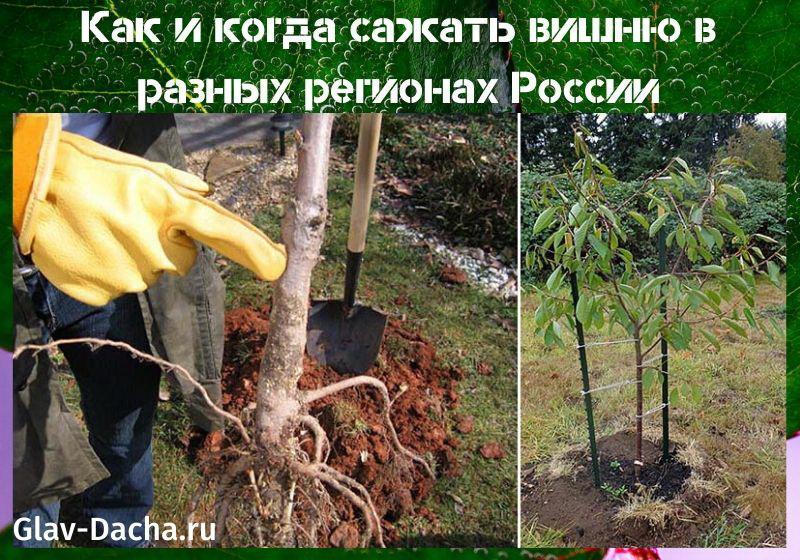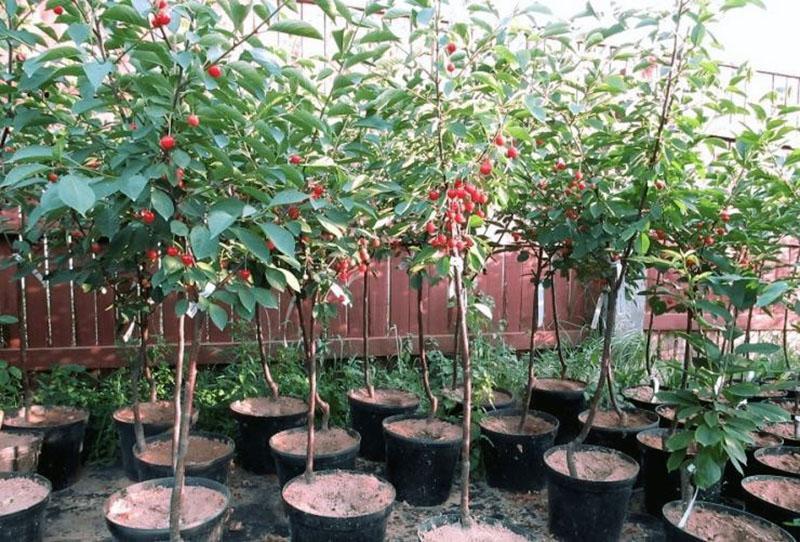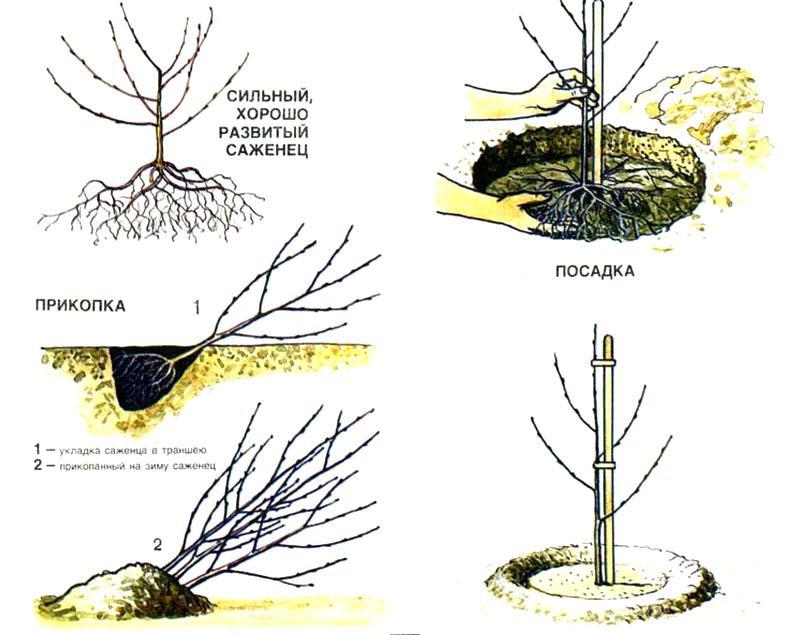How and when to plant cherries in different regions of Russia
 Cherry perfectly tolerates the harsh climate of Russia, which is why it is often grown by summer residents almost throughout the country. For the excellent development of the seedling, the health of the tree and a large harvest, the rules and timing of planting must be observed. When to plant cherries depends on the region and the preferences of the summer resident. Although planting in spring and autumn has some peculiarities, both methods have a right to exist.
Cherry perfectly tolerates the harsh climate of Russia, which is why it is often grown by summer residents almost throughout the country. For the excellent development of the seedling, the health of the tree and a large harvest, the rules and timing of planting must be observed. When to plant cherries depends on the region and the preferences of the summer resident. Although planting in spring and autumn has some peculiarities, both methods have a right to exist.
When to plant cherries

Closed-root cherries are small trees grown in pots. These plants can be planted any day of spring or summer. But no later than a month before frost (zero temperature).
But when buying trees with open roots, you need to know when to plant cherries, since such plants are much more sensitive. In the south of the Russian Federation, cherries are installed in autumn, summer and spring. In the western regions, this can be done in spring and summer. At the same time, cherries are planted in the central regions, in the northwest and in Siberia only in spring.
When to plant cherries in autumn
 Cherries can be planted in autumn only in the southern and southwestern regions of the country. This technique is useful, since during the winter the plant will have time to take root in the ground, acquire resistance to cold weather. Within a year, the cherries will become much stronger and will yield a good harvest. But the tree can be installed only during the period when a month remains before the first frost. In our unpredictable climate, it is difficult to guess when to plant cherries.
Cherries can be planted in autumn only in the southern and southwestern regions of the country. This technique is useful, since during the winter the plant will have time to take root in the ground, acquire resistance to cold weather. Within a year, the cherries will become much stronger and will yield a good harvest. But the tree can be installed only during the period when a month remains before the first frost. In our unpredictable climate, it is difficult to guess when to plant cherries.
Before boarding, you can additionally:
- remove all leaves so that the tree does not waste moisture;
- cut off rotten roots;
- if the roots are too dry, then hold the plant in a basin of water for 3 hours;
- moisten the roots in a mixture of clay and rotted manure, which are taken in equal proportions.
When to plant cherries in spring
 Cherries are planted before the beginning of the growing season of plants, that is, until the moment when buds appear and swell on trees. Usually this is the period when the temperature rises to + 5 ° C and above. If you do this after the growing season (and the beginning of the movement of juices in the tree), then the plant will not take root well. In the south, you can plant cherries in March, in the central regions and in the middle lane - in April, and in the Urals and beyond - only in May.
Cherries are planted before the beginning of the growing season of plants, that is, until the moment when buds appear and swell on trees. Usually this is the period when the temperature rises to + 5 ° C and above. If you do this after the growing season (and the beginning of the movement of juices in the tree), then the plant will not take root well. In the south, you can plant cherries in March, in the central regions and in the middle lane - in April, and in the Urals and beyond - only in May.
Autumn ditch of cherries
 This technique can be used if the tree was purchased for autumn planting, but frost came much earlier. To prevent the seedling from dying, you can make a hole in it.
This technique can be used if the tree was purchased for autumn planting, but frost came much earlier. To prevent the seedling from dying, you can make a hole in it.
Follow the instructions:
- Dig a hole so that its depth is about half a meter, make the northern side of the hole steep, and the southern side flat.
- The seedlings are laid on the south side of the pit.This is done so that the top of the tree is illuminated as much as possible.
- Cover the roots and the lower third of the trunk.
- Water the plant.
- After the onset of frost, apply more soil, covering the tree by 2/3 (along with the branches).
If there is little snow, then you need to scoop it up on the seedling so that there is a small snowdrift.
Planting trees on the lunar calendar is a superstition. There is no evidence that the lunar cycle affects when to plant cherries. Sites that talk about the alleged existence of such studies do not provide any links to reliable sources.
What seedlings to choose
 It is recommended to purchase seedlings in specialized stores in your region, as well as to buy only those varieties that are adapted to the climatic characteristics of the area. Usually they are sold in containers, large pots already in the form of a meter long tree. Such seedlings with a closed root system take root better, but they are also more expensive.
It is recommended to purchase seedlings in specialized stores in your region, as well as to buy only those varieties that are adapted to the climatic characteristics of the area. Usually they are sold in containers, large pots already in the form of a meter long tree. Such seedlings with a closed root system take root better, but they are also more expensive.
Here is a small list of common guidelines:
- Pay attention to the appearance, absence of diseases, dry leaves, cracks in the trunk.
- The height of the seedling should be in the region of 1-1.5 meters.
- You cannot buy trees older than two or three years, they will not take root.
- It is better not to take large plants, as it may turn out to be a seedling that will hit its growth hard, but it will almost not bear fruit.
- There should be no moldy smell from the tree.
- Seedlings with a closed root system must hold firmly in the container.
- The grafting site must be visible on the tree, this is a guarantee that it is not wild.
- The trunk should be flat, without distortion, flaking.
- There should be no growths and cracks or breaks on the roots.
- The richer the root system, the better. There should be at least 1 main root and 4-5 lateral ones.
- The shortest root is at least 20-25 cm.
Site selection and preparation
 Cherries are picky about the planting site, so choose carefully. The plot must be flat, without slopes, on the south side of the house, so that it is well lit. It is desirable that it be protected from the north by a wall or fence. The optimal groundwater level is located at least 2 meters from the surface.
Cherries are picky about the planting site, so choose carefully. The plot must be flat, without slopes, on the south side of the house, so that it is well lit. It is desirable that it be protected from the north by a wall or fence. The optimal groundwater level is located at least 2 meters from the surface.
2.5-3 meters should be retreated from all large trees in the neighborhood. Ideally, plant several cherries at once for pollination. Otherwise, the yields will be small.
In this case, it is recommended to take different varieties of plants. Planting technology in spring and autumn is the same.
The soil
 It should be loose, moderately moist and very nutritious. Cherry loves black soil with neutral acidity. Drainage should be created on clay soil, and humus and clay should be added to sandy soil. After digging a hole, a planting stake is driven into it, to which a tree will need to be tied. The support is placed before planting the tree and burying it with earth, in which case the stick will hold firmly.
It should be loose, moderately moist and very nutritious. Cherry loves black soil with neutral acidity. Drainage should be created on clay soil, and humus and clay should be added to sandy soil. After digging a hole, a planting stake is driven into it, to which a tree will need to be tied. The support is placed before planting the tree and burying it with earth, in which case the stick will hold firmly.
Fossa preparation
 They must be dug out in advance 2 days before planting, and preferably 1-2 weeks. Normally, the pit exceeds the root lobe by 20% in height and width. Usually it is about 60 * 60 cm. If a cherry with a closed root system was bought, then the size of the pit should exceed the container by 2-3 times. The walls must be made vertical (ideally, exactly 90o). This is necessary for normal root development.
They must be dug out in advance 2 days before planting, and preferably 1-2 weeks. Normally, the pit exceeds the root lobe by 20% in height and width. Usually it is about 60 * 60 cm. If a cherry with a closed root system was bought, then the size of the pit should exceed the container by 2-3 times. The walls must be made vertical (ideally, exactly 90o). This is necessary for normal root development.
Cherry pits should be 3 meters apart. For shrub species, the gap can be reduced to 2 meters.
If many plants are planted in several rows, then the distance between the rows must be 4 meters. At such distances, the trees will not interfere with each other, and it will be convenient for the summer resident to take care of them and harvest.
Food
 If the earth is heavy, clayey, or if the groundwater lies 1.5 meters from the surface or closer, then a 10 cm thick drainage layer in the form of rubble should be placed on the bottom of the dug holes. If, on the contrary, it is light and sandy, then you can use non-acidic peat.
If the earth is heavy, clayey, or if the groundwater lies 1.5 meters from the surface or closer, then a 10 cm thick drainage layer in the form of rubble should be placed on the bottom of the dug holes. If, on the contrary, it is light and sandy, then you can use non-acidic peat.
For fertilization, you can use the following products:
- Top cut (30 cm) of soil, which was formed when digging a hole.
- Humus or compost (but not fresh to prevent the roots from burning). A 10 liter bucket is enough.
- Large glass (300 g) superphosphate and 70 g of potassium sulfate.
- Instead of the previous option, you can use 300 g of nitroammophos. This method is better because the nitrogen content will be optimal.
Cherry planting technique

Follow the instructions:
- Pits 60 cm wide and deep are dug at a distance of 3-4 meters from each other. The walls of the holes are made straight, under 90o... Then a support peg is driven in. After that, it is advisable to wait a week, and then plant cherries.
- If a tree with open roots is used, then a small mound should be poured at the bottom of the hole, and already a seedling should be placed on it and the roots should be spread. If the plant has a closed root system, then this step can be skipped.
- The root collar must be located 3-5 cm above ground level. Its placement too high or low impairs the development of the tree.
- The cherry is tied to a support peg higher with a soft twine.
- Then you can cover the roots of the seedling with earth. In this case, it is advisable to straighten, shake the tree slightly so that the soil penetrates deeper. It is more convenient to do this together.
- Then you need to compact the earth lightly with your hands, and then pour a 10 cm high roller around.
- Next, you need to water the tree with water. You will need 3 buckets for one seedling. However, you cannot do this immediately. First, one bucket is poured out, then you have to wait. The second bucket can be used when the water from the first is completely absorbed. They do the same with the third.
- If the earth settles after watering, then it must be filled up.
- Next, you need to loosen the ground and mulch a roller around the trunk (with peat or compost). Distance is needed between the trunk and the fertilizer so that the bark is not damaged.
 It is advisable to plant cherries in the spring so that they have time to adapt. The ideal time is April. It is necessary for the soil to warm up, become loose, and the air temperature was above +5 oC. In the southern regions, autumn planting can be practiced, but no later than a month before frost. Of course, for planting, you need to choose the right plant, prepare the ground and pits, and follow the technique.
It is advisable to plant cherries in the spring so that they have time to adapt. The ideal time is April. It is necessary for the soil to warm up, become loose, and the air temperature was above +5 oC. In the southern regions, autumn planting can be practiced, but no later than a month before frost. Of course, for planting, you need to choose the right plant, prepare the ground and pits, and follow the technique.